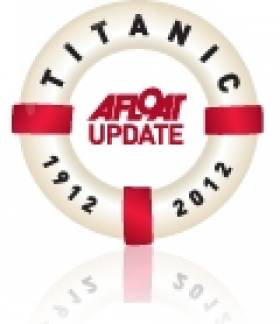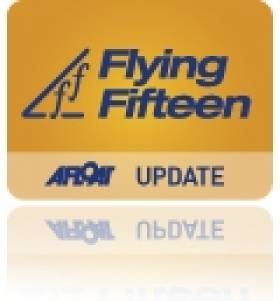Displaying items by tag: Carrickfergus
Plaque Honours Famous Playwright and Titanic Orphan
#TITANIC - A plaque honouring Titanic orphan and playwright William Ruddick Millar has been unveiled in his hometown of Carrickfergus, the News Letter reports.
Millar was orphaned at five years old when his father, a deck engineer on the ill-fated ocean liner, went down with the ship after it struck an iceberg on 15 April 1912.
He faced a difficult childhood, he and his brother Thomas joining their eight cousins under the care of a great aunt.
But by the age of 18 he had already seen one of his plays performed at the Grand Opera House in Belfast.
In the decades after he became a renowned author famous for titles such as Stirabout, When Johnny Comes Marching Home and The Land Girl. He also wrote for radio as well as books and newspaper articles.
Great-granddaughter Susie Millar was on hand for the unveiling at the cottage where he was raised by his great aunt. “Our entire family are so proud to have him remembered in this way," she said.
The News Letter has much more on the story HERE.
Home With Views of Belfast Lough is Sure to Impress
#WATERFRONT PROPERTY - A stunning four/five-bed home with extensive views over Belfast Lough could be yours for less than €500,000.
Accommodation at 36 Loughview Village in Carrickfergus comprises a lounge with feature fireplace with a natural stone surround, as well as a dining room and sunroom.
The kitchen is fitted in a range of high and low-level cream country-style units and butcher block work surfces, and a downstairs WC.
On the first floor there are four bedrooms including master bedroom with en-suite, a family room, upstairs sunroom and white family bathroom suite.
The detatched property boasts PVC double glazing and gas-fired central heating.
Gardens to the front and back are laid in lawn with a paved pathway and patio area respectively.
The home also has the added bonus of an attached garage and tarmac parking.
Estage agents Home and Away Properties are offering this home at a bargain price of £350,000 (€417,661), and strongly recommend an early appointment to view to avoid disappointment as internal inspection will be sure to impress.
Property.ie has more details on this property HERE.
Waterfront Development Opportunities in Northern Ireland, Waterford
#WATERFRONT PROPERTY - A number of prime waterside development opportunities are up for grabs in Northern Ireland and Waterford.
North of the border, Northern Ireland Electricity (NIE) is currently seeking expressions of interest for three sites.
The first of these, in Belfast, is the site of the former Belfast West Power Station. The 16-acre site on McCaughey Road, close to the city centre, is currently zoned as employment/industry.
Further north on the shores of Belfast Lough is a 45-acre whiteland site adjacent to Kilroot Power Station in Carrickfergus. Both Kilroot and Belfast West will be available for lease only due to their strategic nature.
Also available are lands adjacent to Coolkeeragh Power Station, near Derry and the mouth of the Foyle. This 28-acre site is zoned as existing industry.
All three sites are restricted to generation or other electricity industry uses.
The closing date for expressions of interest is 12 noon on 20 February 2012. For more contact Savills Belfast at +44 (0) 28 9026 7820 or [email protected].
Meanwhile, in Waterford, estage agent Purcell Properties is guiding €1.5 million for an 18-acre landbank with extensive frontage on the Suir, less than a mile from the city centre.
The site at Newrath, previously used by Smurfit for plastic production, comprises mixed warehousing developed around 50 years ago.
The landbank is close to the new bridge connecting with the Waterford-Dublin motorway. Zoning of the site would allow mixed use including retail, light industrial and warehousing.
For more details contact Purcell Properties at 051 876 514 or [email protected].
Boat Jumbles for Dun Laoghaire, Howth and Carrickfergus
If you fancy a rummage through a Bosun's locker then boat Jumble sales on three consecutive weekends and at three separate locations will satisfy all bargain hunters when the Irish boating season kicks off in a fortnight's time.
Each show is offering a range of boating, sailing and water sports equipment and accessories. There are new and used pitches and some familiar trade names in addition to second hand boats/dinghies and nautical “car boot” items.
The first opens on March 27th – the weekend when the clocks go forward – and it takes place on the Carlisle Pier in Dun Laoghaire Harbour from 10am to 4pm.
The next is across Dublin Bay when the RNLI stage a boat jumble at Howth Yacht Club on Saturday 2nd April from 10.30am to 1.30pm.
The last show is at Carrickfergus on Belfast Lough and this 'Irish Boat Jumble' is being promoted as the 'biggest' in Ireland. The Antrim show will be on Sunday 10th April starting at 10am.
All are offering economical rates and friends are being encouraged to team up and pool their surplus gear and share the selling task!
Martin and Murray Crowned Flying Fifteen Champions
The Northern pairing posted a credible third and a first in massively shifting light winds yesterday to clinch the Irish title in a 30 boat fleet. Dubliners John Lavery and David O'Brien were second. Third was Brian McKee and Steven Martin also of Strangford Lough. Full Results HERE.
At the Irish Flying fifteen National Championships on Belfast Lough today Darren Martin and Simon Murray lead but only on tie break after four tight races off Carrickfergus. Dun Laoghaire pairing John Lavery and David O'Brien are second but both teams have five nett points going into tomorrow's final two races. Third overall is Lavery's National YC club-mates David Gorman and Chris Doorly on nine points. Conditions thus far for the 30-boat fleet have featured sihfty, westerly winds gusting to 14 knots with a choppy sea. Slightly lighter winds from the north west are forecast for tomorrow. Full Results HERE!
Carrickfergus Sailing Club
History (to 1984)
Carrickfergus Rowing Club, founded in 1866 by Charles H. Crawford, is the oldest sporting club in Carrickfergus and one of the earliest rowing clubs to be established in Ireland. By early 1867 membership had reached thirty and a four-oared racing gig had been delivered by Matt Taylor, boat builder of Newcastle-upon-Tyne, at a cost of £35. Crews from Carrickfergus competed with great enthusiasm in many northern Regattas, achieving their first win at a local event in 1870.
Prior to the completion, in 1874, of the first Clubhouse boats were stored in premises belonging to the Antrim Artillery, on the site of the present Town Hall, and carried across the rough shingle beach for launching. This Clubhouse, a wooden structure supported on piles, was erected behind the East Pier with the consent of the Carrickfergus Harbour Commissioners. Work was supervised by Paul Rodgers of the shipyard, at that time a member of the Club, and cost approximately £150. The building was replaced in 1888 and again in 1902 following storm damage.
Until the establishment in 1891 of the Carrickfergus Sailing Club the Rowing Club’s Annual Regatta included sailing and swimming events as well as rowing. Judging by the Secretary’s remarks in his Annual Report the introduction, on the occasion of the coronation in 1911, of Ladies Rowing Races was not universally welcomed and it was not until 1921 that ladies were admitted to Club membership. Tennis was then introduced and in 1922 the Rowing and Sailing Clubs amalgamated. The Club, then known as "Carrickfergus Amateur Rowing Club incorporating Carrickfergus Sailing Club", continued to promote rowing, sailing, swimming and tennis. Membership however continued to decline and it was not until 1934 that the Annual Regatta was again held. This year also saw the launching of a new Clinker Four named Fairey II and the beginnings of the Open Eighteen Foot Centre Board Class. Crews from Carrickfergus continued to enjoy considerable success at Regattas until the early fifties when competitive rowing ceased. The last Clinker Four to be purchased arrived in 1950. Named "Castle Dobbs" it was little used and remains in the Club’s possession to this day. Tennis also faded out after the Second World War and Snipes took the place of the old eighteen footers.
The building in 1957 of three flying fifteens by members of the Club introduced a class which is still popular today with up to twenty boats competing. GP Fourteens and Optimists were raced for some years before being superceded by Scorpions and Mirror Dinghys. A strong Mirror fleet still exists but Scorpions are no longer raced as a class.
In 1966, the Club’s Centenary Year, an ambitious project involving the construction of a two storey extension and improvements to the interior layout of the building was completed. The provision of a bar in 1968 was the last major alteration to be carried out on the East Pier site.
Although cruising boats had from time to time been owned by members of the Club it was not until the mid-nineteen seventies that cruisers began to appear in any number in the Club’s handicap series. The cruising fleet has grown rapidly over the past decade both in size and number with upwards of twenty boats now competing in the IOR, SL and Ruffian 8.5 Classes.
Lack of finance, small membership and the frequent need for repairs to the building and supporting structure have caused successive Committees concern since the earliest days of the Club. In 1980 with repairs to the front platform urgently needed and further development on the East Pier site to meet our requirements not possible the Committee again considered the alternatives and at the Annual General Meeting of the Club in March 1981 recommended the acceptance of a 2.2 acre site offered by Carrickfergus Borough Council on reclaimed ground adjacent to the West Pier. The Members unanimously agreed and construction began in early May. Three years later with the Council’s Yacht Harbour taking shape alongside our new premises the future of the Club and of Carrickfergus as a major boating centre seems assured.
G.J.E. ALCORN, Hon. Secretary
Carrickfergus Sailing Club, Rodger's Quay, Carrickfergus, Co. Antrim BT38 8BE. Tel: +44 28 93351402, fax: +44 44 870 7066157, email: [email protected]
Have we got your club details? Click here to get involved



































































